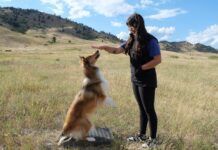Does your dog exhibit autism-like behavior? I have had several clients ask me if their dog could have autism and whether this could explain their dog’s behavior. In humans, autism spectrum disorder (ASD) is characterized by persistent deficits in two core areas from early in a child’s development. These include socio-communication (e.g. poor communication and social skills, impaired emotional connection) and restricted, repetitive patterns of behavior (e.g. stereotypic movement, fixated interests and insistence on rigid routines). In dogs, these behaviors are more commonly known as canine dysfunctional behavior.
What is Canine Dysfunctional Behavior?
Canine dysfunctional behavior is an idiopathic condition, meaning that we don’t yet know what definitively causes it. It is believed that dogs with canine dysfunctional behavior are deficient in mirror neurons, which are believed to be important for helping dogs and puppies “mirror” other dogs’ behaviors when socializing. Canine dysfunctional behavior is currently poorly understood but is thought to mimic a number of autism-like behaviors in humans. Indeed, researchers have identified dogs as a model for many human neuropsychiatric conditions, including ASD due to the similarities in symptoms.
Symptoms of Canine Dysfunctional Behavior
Although a definitive list of symptoms of canine dysfunctional behavior is currently lacking, there are a number of common symptoms that are believed to indicate canine dysfunctional behavior. These include:
Obsessive compulsive behaviors
These include repetitive or stereotypical movement or actions such as tail chasing, circling, fly snapping, excessive licking or chewing, or pacing in the yard along a well-worn path. Obsessive compulsive behaviors interfere with normal function and can negatively impact wellbeing and welfare.
Inappropriate responses to situations or stimuli
A dog with canine dysfunctional behavior may overreact in response to stimuli or situations considered quite normal for a dog. For example, they may yelp in response to gentle touch, over-react to sudden noises, or shut down and retreat from unfamiliar environments or situations.
Poor communication
Dogs with canine dysfunctional behavior may be poor at communicating their feelings and emotions with us and other dogs through their behavior and body language. For example, avoiding eye contact.
Trance-like behavior and episodic aggression
Sudden explosive aggression and trance like behavior have been observed in dogs and is believed to be linked to canine dysfunctional behavior.
How Is It Diagnosed?
Canine dysfunctional behavior is difficult to diagnose due to its similarity to several other conditions such as canine compulsive disorder, canine anxiety disorders, and other neurological disorders. Furthermore, canine dysfunctional behavior is not yet well understood. If you believe canine dysfunctional behavior is the cause of your dog’s behavioral issues, it’s best to seek professional help from your veterinarian for a thorough examination and informed diagnosis. This may involve a referral to a veterinary specialist for further investigation.
What Does the Research Say?
Currently, very little research exists investigating canine dysfunctional behavior in dogs. However, the available research has found that some dog behavioral issues such as tail chasing in Bull Terriers may serve as an indication of autism-like behaviors. Tail chasing is a stereotypical behavior closely associated with owner-directed explosive aggression, trancing, social withdrawal, and a persistent obsession with objects (Topál et al., 2019) [1]. Furthermore, dogs that tail chase have been found to cope poorly with stressful situations. Interestingly, male dogs are affected more often than females (Moon-Fanelli et al., 2011 [2]) which is also the case with autism in humans.
In another study, results from a dog owner survey on the social behaviors of Miniature and Standard Poodles indicated autism-like behaviors in individuals of these breeds (Zamzow, et al., 2017 [3]). It has also been found that puppies that react negatively to being touched by a human handler are more likely to be withdrawn from the guide dog training program than more sociable subjects (Asher et al., 2013 [4]). In a study by Protopopova et al. (2014 [5]), dogs that showed a predisposition for stereotypic behaviors differed from the normal population in terms of their cognitive flexibility. The researchers found that they showed increased resistance to extinction in a reversal learning task.
How To Manage Canine Dysfunctional Behavior
There is no known cure for canine dysfunctional behavior. However, identifying your dog’s triggers can be help you manage or avoid the situations that may set your dog off and exacerbate their behavior. It is also important to understand that some aspects of canine dysfunctional behavior may not improve, such as your dog’s social interaction skills, and these dogs are best managed in a way so as to avoid causing distress.
Dogs that have been diagnosed as having canine dysfunctional behavior may benefit from the implementation of a consistent routine including regular exercise and mental stimulation to help minimize stress and anxiety. They may also benefit from behavior modification training to improve their ability to cope with triggering stimuli or situations, and in some cases, your veterinarian may prescribe medications to help reduce anxiety and compulsive behaviors.
References:
[1] Topál, J., Román, V., & Turcsán, B. (2019). The dog (Canis familiaris) as a translational model of autism: It is high time we move from promise to reality. Wiley Interdisciplinary Reviews: Cognitive Science, 10(4), e1495.[2] Moon-Fanelli, A. A., Dodman, N. H., Famula, T. R., & Cottam, N. (2011). Characteristics of compulsive tail chasing and associated risk factors in Bull Terriers. Journal of the American Veterinary Medical Association, 238(7), 883-889.
[3] Zamzow, R. M., Lit, L., Hamilton, S., & Beversdorf, D. Q. (2017). Characterizing autism-relevant social behavior in poodles (Canis familiaris) via owner report. Journal of Comparative Psychology, 131(2), 139.
[4] Asher, L., Blythe, S., Roberts, R., Toothill, L., Craigon, P. J., Evans, K. M., … & England, G. C. (2013). A standardized behavior test for potential guide dog puppies: Methods and association with subsequent success in guide dog training. Journal of Veterinary Behavior, 8(6), 431-438.
[5] Protopopova, A., Hall, N. J., & Wynne, C. D. (2014). Association between increased behavioral persistence and stereotypy in the pet dog. Behavioural processes, 106, 77-81.







Great article! Thank you. I will be sharing this info with my clients.